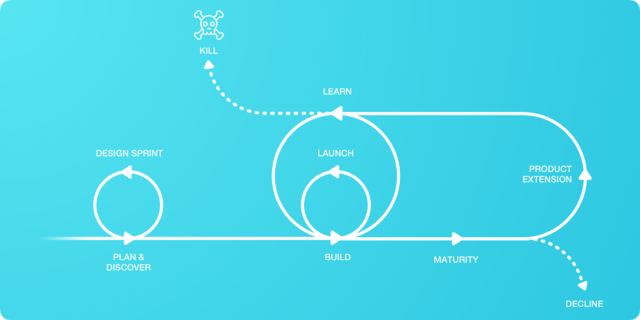Product Development

Product Development
The Product Development Cycle and Product Life Cycle will ensure your product’s success. Discovery methodologies, modest iterations, and constant innovation.
Elementos employs continuous discovery across the product development cycle to align design and development teams and evaluate customer expectations. Use the designers’ and developers’ skills when deciding what to construct and how to deliver it. Also, link customer support, sales, and marketing teams with the product.
Elementos delivers products or new features in tiny iterations to reach users rapidly and assesses their effect to help you improve the product. This may be done using Scrum or Kanban. Design Sprints and Design workshops generate creativity, solve issues, and validate with actual consumers.
Phases of Product Development
1 - Plan and Discover
To understand the market, you are planning to enter; you will need to conduct market research, benchmarking, and competitive analysis. This research needs to identify your target audience, valid need for the product, any competitors, how you are planning to compete, and lastly, the potential market share for your product.
In addition to the services described above, Elementos can assist you in writing a business case, a product roadmap, and a strategic plan for your firm. These documents will help your business articulate and show the necessary steps to ensure the success of your product.
2 - Build
Here, software, hardware, or a mix of both are created.
It would be best to share your team’s planning and discovery lessons to succeed at this step. By employing planning approaches that engage team members, the team will grasp client expectations, technical requirements, and how the product fits in the market.
With design and development, split the plan into achievable releases and record user stories. Once the individual features are developed, they should be prioritized by priority and complexity to determine the most significant and build a completion timeline.
The initial product release will have some features you or your stakeholders want since you must balance elements and time to market. The initial version will likely be an MVP (minimum viable product), including the product’s essential features.
After your MVP release, you’ll need to collaborate with the design and development teams to add new features and maintain a viable product. As you create the product, revisit discovery and planning to verify new features, test new technologies, and revise your roadmap. Managing this will guarantee a quality product release and allow you to review it immediately after it’s online.
3 - Launch
As you finish the product’s initial version, you must be ready to launch it. This stage of product development is comparable to PLC’s Introduction.
You may publicize your product launch with press releases, interviews, advertising, or launch events. Product Hunt combines physical and digital launch events.
Sales and Operations must work closely together in the weeks and months before and after a product launch. Set up measures to monitor product use and performance after launch to prepare for assessment and review.
4 - Learn
Collecting and analyzing metrics helps assess a product’s performance. Some evaluation and analysis choices include A/B testing, improving ROI, and evaluating what makes a recurring consumer. Each product feature must be tested and reviewed to see whether it should be kept, iterated, or deleted.
Customers’ comments will be used to assess the product, as in planning and discovery. You’ll discover how well the product meets its requirements, how to enhance it, and what features need iteration.
5 - Iterate or kill
After launch, products should be monitored. Using assessment and evaluation lessons, you and the team may decide which product aspects to iterate on and which to discard.
Remove customer-unfriendly features that don’t produce engagement or money. Customers should be notified about feature removals.
6 - Maturity
The preserved features must be improved to remain competitive. Your staff will be accustomed to working well together and will spend most of their time maintaining the product, addressing problems, and increasing features.

Bonus: How does it all fits together?
We created an additional model to explain how all the Product Development Cycle and Design Sprints fit together within the Product Life Cycle.
Get In Touch With Elementos
Call
(910) 691-2474

